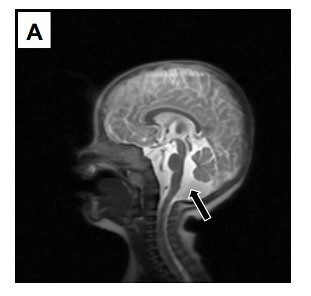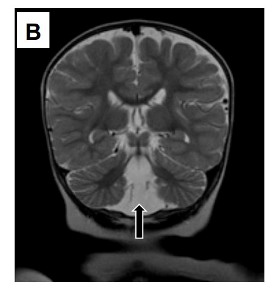Servicios Personalizados
Revista
Articulo
Indicadores
-
 Citado por SciELO
Citado por SciELO
Links relacionados
-
 Similares en
SciELO
Similares en
SciELO
Compartir
Revista Medica Herediana
versión impresa ISSN 1018-130X
Rev Med Hered v.23 n.1 Lima mar. 2012
Síndrome de Dandy Walker.
Dandy Walker sindrome.
Alan Palomino 1, Carlos Carrasco 2
1Médico Residente de Radiología de segundo año. Hospital Nacional Cayetano Heredia. Lima, Perú.
2Médico Asistente, Dpto. de Radiología. Hospital Nacional Cayetano Heredia. Profesor Auxiliar. Facultad de Medicina Alberto Hurtado. Universidad Peruana Cayetano Heredia. Lima, Perú.
Lactante varón de 12 meses de edad, con retardo psicomotor. La Resonancia Magnética Nuclear en T2 mostró: A (Corte sagital sin contraste): dilatación quística del IV ventrículo que produce agrandamiento de la fosa posterior y elevación del tentorio (flecha) y B (Corte coronal sin contraste): hipoplasia del vermis cerebeloso (flecha) ( Figura 1 y figura 2). Con estos hallazgos se hizo el diagnóstico de Síndrome de Dandy Walker. Es una malformación cerebral que compromete el cerebelo que suele aparecer en la infancia, su incidencia se estima en 1:25000 nacimientos y clínicamente se caracteriza por macrocefalia, crisis comiciales y retardo en el desarrollo psicomotor.
Male infant 12 months of age, with psychomotor retardation. Magnetic resonance imaging showed: A (Sagittal non-contrast): cystic dilation of the fourth ventricle that produces an enlarged posterior fossa and tentorium elevation (arrow) and B (Coronal non-contrast): hypoplasia of cerebellar vermis (arrow). With these findings we made diagnosis of Dandy Walker Syndrome. It is a brain malformation that involves the cerebellum that usually appears in childhood, its incidence is estimated at 1:25000 births and is characterized clinically by macrocephaly, seizures and psychomotor retardation.















